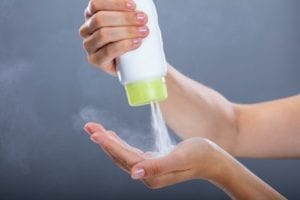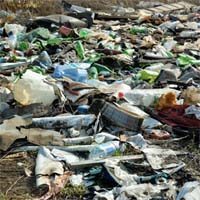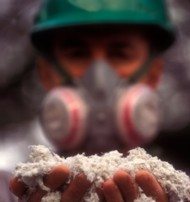Cosmetic Talc Can Cause Mesothelioma, Study Finds

A new study in the American Journal of Industrial Medicine appears to offer definitive evidence that repeated exposure to cosmetic talc can cause mesothelioma.
It is an issue that has come up repeatedly in courtrooms in recent years. Lawyers for mesothelioma patients who have used cosmetic talc say the products are unsafe. Manufacturers like Johnson & Johnson insist they are pure.
But the new study shows that may not be the case. If the product is contaminated with asbestos, as many appear to be, the study shows cosmetic talc can cause mesothelioma.
How Can Cosmetic Talc Cause Mesothelioma?
Talcum powder is made from talc, which contains magnesium and silicon. Because it absorbs moisture, people use it to keep skin dry and prevent rashes from friction. Some animal studies on pure talc have suggested it can cause tumors. But the International Agency for Research on Cancer (IARC) does not classify it as a known carcinogen.
The bigger problem is asbestos, which is known to cause cancer. Deposits of talc and asbestos lie close together in the ground. Cosmetic talc can cause mesothelioma because some of it contains small amounts of asbestos.
When asbestos fibers get into the body, they never leave. They can trigger malignant mesothelioma even years after exposure. The longer a person is exposed to asbestos, the more likely they are to receive a mesothelioma diagnosis.
Asbestos-Tainted Talc and Mesothelioma
Researchers interviewed 140 people with documented exposure to cosmetic talc. They chose 75 to be part of the new study on whether cosmetic talc can cause mesothelioma. Sixty-four of the patients were men and 11 were women. All had confirmed cases of malignant mesothelioma.
Scientists cannot be sure the exact concentration of the talc these people encountered. But they do know that the study participants had an average of 33 years of exposure to cosmetic talc. None of them lived or worked around asbestos, so the talc was their only known exposure.
Malignant mesothelioma usually occurs in older people, but 16 percent of the study subjects were younger than 45. Forty-eight people had pleural mesothelioma, 23 had peritoneal mesothelioma, and two patients had both kinds. One person had testicular mesothelioma and another had it around their heart, called pericardial mesothelioma.
In eleven cases, scientists examined their tissue under high-end microscopes for signs of asbestos fibers.
Results of the Latest Talc Study
“Of the 11 individuals whose nontumorous tissues were analyzed for the presence of asbestiform fibers, all showed the presence of anthophyllite and/or tremolite asbestos,” writes lead author and pathologist Theresa Emory, MD.
This suggests that there was definitely asbestos in their talcum powder and that cosmetic talc can cause mesothelioma. The findings may help with current and future legal cases against cosmetic talc producers.
Dr. Emory and her colleagues conclude, “Mesotheliomas can develop following exposures to cosmetic talcum powders. These appear to be attributable to the presence of anthophyllite and tremolite contaminants in cosmetic talcum powder.”
Sources:
Emory, TS, et al, “Malignant mesothelioma following repeated exposures to cosmetic talc: A case series of 75 patients”, March 16, 2020, American Journal of Industrial Medicine, Epub ahead of print, https://onlinelibrary.wiley.com/doi/full/10.1002/ajim.23106\
Talcum Powder and Cancer, American Cancer Society website, Accessed March 21, 2020, https://www.cancer.org/cancer/cancer-causes/talcum-powder-and-cancer.html





